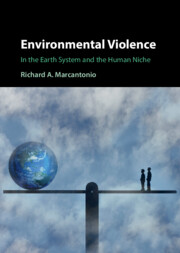
- Cited by 6
-
Cited byCrossref Citations
This Book has been cited by the following publications. This list is generated based on data provided by Crossref.
FitzGerald, Garrett 2024. Why not to blow up a pipeline: Intersectional reflections on environmental (non)violence. Peace & Change,
Stock, Paul 2024. Exploring Environmental Violence. p. 301.
Wilmes, Andreas 2024. Violence as a technological concept. South African Journal of Philosophy, Vol. 43, Issue. 2, p. 184.
Astorquiza, Santiago Navarrete 2024. Exploring Environmental Violence. p. 238.
2024. Exploring Environmental Violence. p. 133.
2024. Exploring Environmental Violence. p. 259.
- Publisher:
- Cambridge University Press
- Online publication date:
- July 2022
- Print publication year:
- 2022
- Online ISBN:
- 9781009170802


